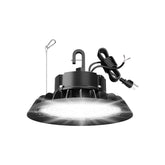How Does The Lighting Driver Work?
Definition
A lighting driver is an electronic device used to control and regulate the power supply of lighting equipment, such as High Bay LED lights. It plays a crucial role in the lighting system, ensuring that the lighting equipment operates stably and efficiently.
Working Principle
Its main function is to convert the input power supply (such as alternating current) into an output power supply suitable for the lighting equipment (usually direct current), and precisely control the current and voltage according to the requirements of the lighting equipment. For example, for LED lights, their light - emitting characteristics are closely related to the passing current. The lighting driver ensures that the LED lights emit stable and uniform light by stabilizing the current.

Classification by driving mode
-
Constant - current type
- Characteristics: It can provide a constant current for the LEDs. The output current does not change with the load (such as the number of LED beads). Even if the forward voltage of the LEDs fluctuates within a certain range, the current passing through the LEDs can remain stable, thus ensuring the consistency of the LED’s luminous brightness.
- Application scenarios: It is suitable for occasions with high requirements for brightness consistency, such as showcase lighting in commercial lighting and stage lighting, which can ensure the color rendering and display effect of the illuminated objects.
-
Constant - voltage type
- Characteristics: The output voltage remains constant, while the output current changes with the load. Its circuit is relatively simple and the cost is low.
- Application scenarios: When multiple LEDs are used in parallel and the requirement for the current consistency of each LED is not particularly high, a constant - voltage driver can be used. For example, some ordinary indoor decorative lighting, such as LED light strips.
Classification by circuit structure
-
Switching type
- Characteristics: It realizes the conversion and adjustment of voltage and current through high - frequency switching actions, with high efficiency, generally reaching 80% - 95%. It can adapt to a wide input voltage range and effectively reduce energy consumption. However, the circuit is relatively complex and will generate certain electromagnetic interference.
- Application scenarios: It is widely used in various types of LED lighting products, especially high - power LED lamps, such as street lights and industrial and mining lamps, to reduce energy consumption and operating costs.
-
Linear type
- Characteristics: The circuit structure is simple, the cost is low, and the electromagnetic interference is small. However, the efficiency is relatively low and it generates a large amount of heat. It is usually only suitable for low - power LED lighting.
- Application scenarios: It is suitable for occasions that are sensitive to cost, have low power requirements, and have low requirements for electromagnetic interference, such as small LED indicator lights and low - power decorative lights.
Classification by dimming function
-
Dimmable type
- Characteristics: It can adjust the brightness of the LEDs according to the user’s needs, realizing different lighting scenarios. Common dimming methods include PWM dimming, 0 - 10V dimming, and thyristor dimming.
- Application scenarios: It is widely used in smart home lighting, commercial display lighting and other fields. For example, in a smart home system, users can adjust the light brightness through a mobile APP or a smart switch to create different atmospheres; in commercial displays, the light brightness can be adjusted according to the display content and time to highlight the display effect.
-
Non - dimmable type
- Characteristics: The output current or voltage is fixed and cannot be dimmed. The circuit design is relatively simple and the cost is low.
- Application scenarios: It is suitable for occasions with fixed brightness requirements, such as some places that require long - time lighting without the need to adjust the brightness, such as the constant - on lighting in underground parking lots.








